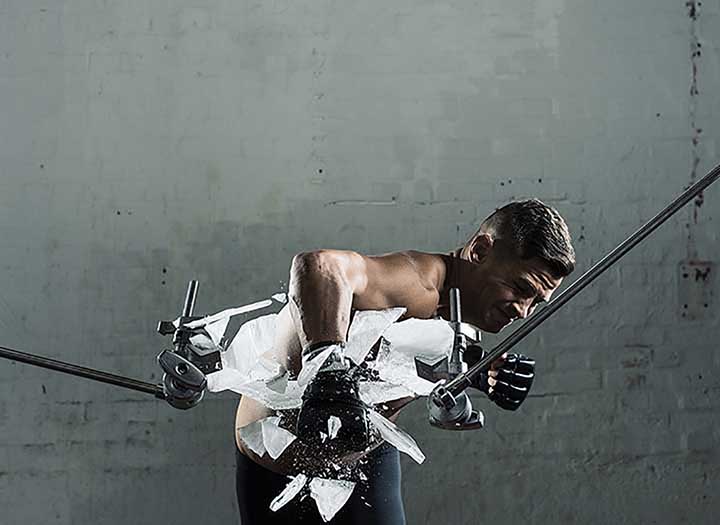Tom Miles series ‘Capturing the Moment’ has sparked inspiration for action photography with eye catching imagesTom Duquesnoy. Here Tom explains more about the background to the shoot and how he captured the images. By sports photographer Tom Miles In photography, the most memorable shot is likely to come from the moment of peak action. It’s important to shoot details and quiet moments, but the shots to aim for are those of impact – the rally car flying over the bump in the road, the boxer’s fist connecting with his opponent, the moment the ball hits the back of the net with the goalkeeper at full stretch. To capture these moments consistently, you need a combination of your ideas, creativity and technique. Using great kit gives you an obvious advantage. The Nikon D500 is a very fast, robust and powerful camera. It’s ideal for capturing such fleeting moments, and it showed when I came to shoot the images for Nikon’s ‘Moment of Impact’ campaign.
Tom Duquesnoy punching through a pumpkin.
This image was shot at 1/250th of a second, f6.3, ISO 800, on a AF-S NIKKOR 35mm f/1.8G on the D500. It was lit by eight Nikon flashguns, three in an umbrella to the right of the camera, two to the rear left, and two to the rear right. I wanted to separate Tom from the background, as well as create a pool of light on the back wall. The flashguns were turned down to 1/16th power or less to allow me to shoot at 10 frames per second.
My thought process for achieving this image was:
- I need to freeze the motion of the object Tom is going to strike
- This means I need a fast shutter speed. But that means I need a lot of light
- I could shoot outdoors on a bright sunny day. But sunny days are not guaranteed in the UK in September. If I shoot indoors, I can control the lighting, but I will need a lot of light to get a usable shutter speed and aperture
- I want to use the burst mode on the D500 to allow me to shoot at 10 frames per second. But if I use the flashguns at full power, they take five or six seconds to recharge each time, so I’ll only get one shot
- If I turn the flash power down, they’ll recycle much quicker, but I won’t get as much light
- I could turn the ISO up. The D500 works brilliantly at high ISOs, and produces hardly any “noise”
- I’ll turn the ISO up high enough to allow me to run the flashes at 1/16th power, but I can fire off at least a 10 frame burst before the flashes. I’ll set the camera to the maximum flash sync speed (1/250th second) and an aperture of f5.6
- An added bonus of turning the flash power down is that the duration of the flash is now very short – something in the region of 1/10,000th of a second. This is the only light falling on Tom and the things he’s striking and this effectively becomes my shutter speed. That should be fast enough to freeze everything
- If you don’t have much light, something else you can use is a fast prime lens. For this shoot, we used the AF-S NIKKOR 24mm f/1.4G, AF-S NIKKOR 35mm f/1.8G, AF-S NIKKOR 50mm f/1.4G and the AF-S NIKKOR 85mm f/1.4G
I use zooms a lot, but whenever I’m able to use prime lenses I do, because they generally have a faster maximum aperture. I don’t have to stop down so far to reach the lens’ potential – this is usually three stops down from maximum, or thereabouts. If I were using a zoom with a maximum aperture of f4, three stops down would take me to f11, but on an f1.4 prime, it would only be f4. This means I need less light to get a decent exposure, giving me the freedom to turn the flashguns down to keep up with the 10 frames per second burst mode. Shot at 10 frames per second on the D500, all technical info very similar to the above image of the pumpkin, except this was shot on a AF-S NIKKOR 50mm f/1.4G lens. Sometimes, during a live event, you spot something amazing and miss it. But you may be able to recreate the moment under more controlled conditions. There’s no shame in constructing a moment so it can be caught on camera – it’s what professional photographers spend much of their lives doing. With enough preparation, control of your environment and a robust, fast camera at your side, your chances of capturing that perfect moment are so much higher. I’d wish you good luck, but the more you shoot, the luckier you get. So, instead, get out and practice!



